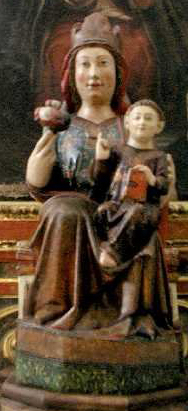Penultimate Saturday in August
Nuestra Señora de Tresfuentes, Valgañón, La Rioja, Spain
 The story goes that in the early 1200s, a girl named Inés was tending
her family's sheep on Pasture Hill in northern Spain when a radiant lady
appeared, saying, "I am, my daughter, the Virgin Mary, Mother of
Jesus, and I want to live here, in this area, always." The Lady
entrusted the girl with a mission to tell the people of the village in the
valley that they must do 40 days' penance to avoid divine retribution for
their sins. At once Inés went down to Valgañón, where her story met
with disbelief and scorn. The next day, when she returned with her flock
to the hill, the Virgin reappeared, giving Inés a most unusual sign so
that people would believe: the print of her fingers, permanently marked on
the shepherdess's left cheek. This time, the villagers took her message
seriously, and many went to do penance in the church. As the spirit of
repentance took hold in the town, after several days the leaders of
Valgañón decided that the whole village should go in sackcloth and ashes
to Pasture Hill. Like others in the procession, Inés carried a heavy
cross. When she reached a spring near the top, she saw the Virgin reappear
in radiance saying, "Have no fear: Drop your heavy load and let your
tears and burdens cease. Go, go lightly and tell your people that my Son
has already heard your cries. He has seen their contrition and accepted
their penances and, through his mercy, they are already pardoned. Let them
shed their grief and seek me in this place and take me down to the village
because from today I want to be the perpetual protector of Valgañon."
Inés delivered this good news to the pilgrims and showed them a statue of
the Virgin and Child, which they carried down to the
church.
The story goes that in the early 1200s, a girl named Inés was tending
her family's sheep on Pasture Hill in northern Spain when a radiant lady
appeared, saying, "I am, my daughter, the Virgin Mary, Mother of
Jesus, and I want to live here, in this area, always." The Lady
entrusted the girl with a mission to tell the people of the village in the
valley that they must do 40 days' penance to avoid divine retribution for
their sins. At once Inés went down to Valgañón, where her story met
with disbelief and scorn. The next day, when she returned with her flock
to the hill, the Virgin reappeared, giving Inés a most unusual sign so
that people would believe: the print of her fingers, permanently marked on
the shepherdess's left cheek. This time, the villagers took her message
seriously, and many went to do penance in the church. As the spirit of
repentance took hold in the town, after several days the leaders of
Valgañón decided that the whole village should go in sackcloth and ashes
to Pasture Hill. Like others in the procession, Inés carried a heavy
cross. When she reached a spring near the top, she saw the Virgin reappear
in radiance saying, "Have no fear: Drop your heavy load and let your
tears and burdens cease. Go, go lightly and tell your people that my Son
has already heard your cries. He has seen their contrition and accepted
their penances and, through his mercy, they are already pardoned. Let them
shed their grief and seek me in this place and take me down to the village
because from today I want to be the perpetual protector of Valgañon."
Inés delivered this good news to the pilgrims and showed them a statue of
the Virgin and Child, which they carried down to the
church.
The story spread, and in 1218, Ferdinand III of Castile placed the first stone of the Church of Our Lady, consecrated November 24, 1224. The title "de Tresfuentes," "of the three fountains," was added in the 1600s, when three spouts were added to the fountain outside the church. The 2-1/2' polychrome wooden statue does appear to date from the 1200s. Now it is kept in the Church of St. Andrew in Valgañón except during the Thanksgiving fiesta on the next-to-last weekend of August.
A cannonade and the pealing of church bells announce the start of festivities at noon on Friday. Saturday's celebration begins with presentation of flowers at dawn. Costumed "giants" conduct the Virgin's statue in procession from the Church of St. Andrew to that of Tresfuentes. In the afternoon, women play a traditional bowling game. A street festival takes place at night. On Sunday after noon mass, there are dancing and games in the plaza. On Monday morning, children have their turn playing games, and in the afternoon, the plaza turns into an open-air kitchen in preparation for the locally famous "Patatada," a communal meal of potatoes, sausage, wine, and coffee served to some 1,500 people at 10:00 pm.
Sources include:
| Valgañon, www.valganion.org | |
| "Advocaciones y Apariciones: VIRGEN DE TRESFUENTES, ESPAÑA ( 17 DE AGOSTO)," Blog de Foros de la Virgen María, foros-virgen-maria.blogspot.com/2009/08/virgen-de-tresfuentes-espana-17-de.html | |
| "Historia/Leyenda," Iglesia de Tresfuentes, www.labscittec.es/valganon/historia_y_leyenda.htm | |
| Photo by C. Lliso, "Iglesia de San Andres," 1ROMANICO.COM, www.1romanico.com |
Also commemorated this day:
| Nuestra Señora de Retejerina,, Prioro, León, Castile and León, Spain Tejerina village. Romería; civil fiesta with dancing, costumes. |